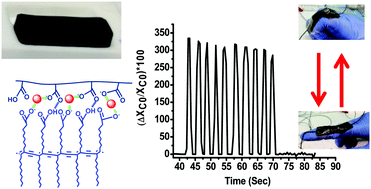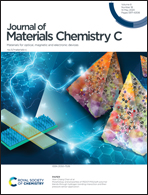Polydiacetylene hydrogel self-healing capacitive strain sensor†
Abstract
Strain sensors are used in varied applications, including personal healthcare monitoring, human–machine interaction, and artificial skin. Here, we report fabrication of a highly sensitive capacitive strain sensor comprising a self-healing polydiacetylene–polyacrylic acid–Cr3+ hydrogel. The dielectric hydrogel medium was prepared through a simple synthesis scheme from readily available ingredients. The elasticity and pronounced sensitivity of the composite hydrogel are attributed to the distinct components of the system. The Cr(H2O)63+ complexes function as cross linkers, maintaining stability of the hydrogel framework through electrostatic binding to carboxylate moieties within both the polyacrylic acid and polydiacetylene, additionally facilitating incorporation of high concentration of water molecules essential for maintaining hydrogel elasticity. In parallel, polydiacetylene, employed here for the first time as a vehicle for strain sensing, endows the system with high intrinsic capacitance sensitivity to mechanical stimuli, further exhibiting a major contribution towards greater flexibility and resilience under high strains. The sensor exhibits high stretchability of 500%, and high sensitivity exhibiting a gauge factor (GF) of up to 160. Applications of the polydiacetylene–polyacrylic acid–Cr3+ capacitive hydrogel sensor for physiological strain monitoring are presented.



 Please wait while we load your content...
Please wait while we load your content...